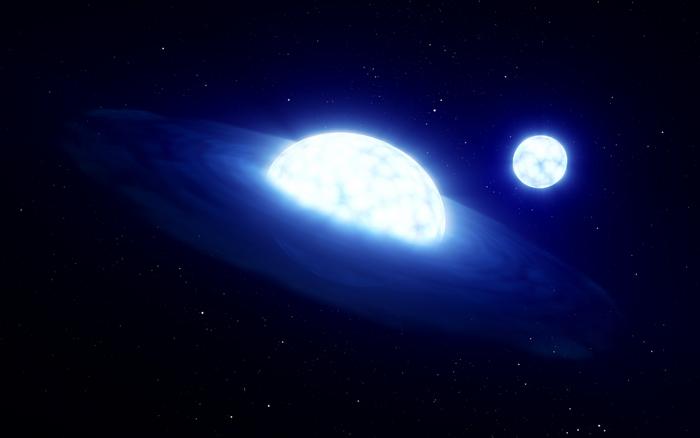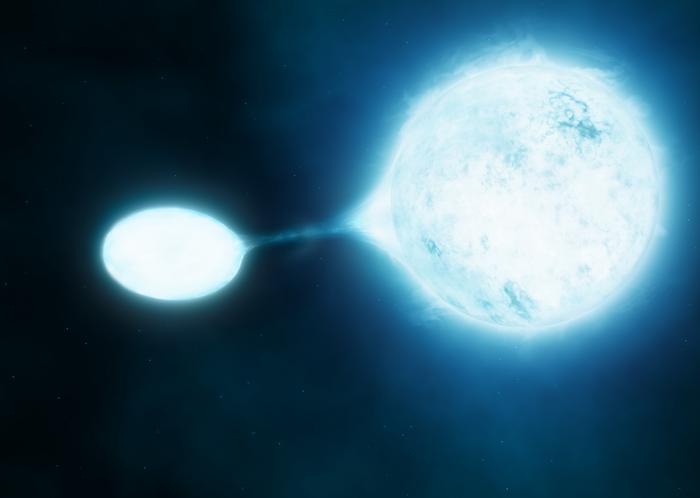
Some star systems believed to host two stellar bodies may actually have a hidden third — a traitorous star that could help push one of its sparkling companions toward the other, as the latter feasts on its victim like a vampire.
Such is a discovery made by University of Leeds scientists who analyzed data from the European Space Agency (ESA) Gaia mission, which pinpoints the positions of a thousand million stars throughout the Milky Way. The revelation could transform our understanding of how the most massive stars in the cosmos evolve.
So-called vampire stars, more officially known as "Be" stars, are characteristically surrounded by rings of superheated gas. They're a subcategory of B stars, which are extremely bright and between 2 and 16 times more massive than the sun. Yet, despite the fact that Be stars were discovered around a century and a half ago, in 1866, quite how the disks around these massive stars form has remained a puzzle.
The leading theory thus far suggests Be disks are created as the stars rapidly rotate, causing them to rip stellar material away from their companion stars. This material stripped from the victim star is also believed to carry along angular momentum that further "spins up" the rotation of the feeding stellar vampires. The team's new research further bolsters the theory, however suggesting Be stars might live in triple star systems rather than double star systems, interacting with two companion stars, not only one.
Related: Dead ‘vampire’ star is feeding on a companion and firing out cosmic cannonballs
"We observed the way the stars move across the night sky, over longer periods like 10 years, and shorter periods of around six months," Leeds University Ph.D. student Jonathan Dodd said in a statement. "If a star moves in a straight line, we know there’s just one star, but if there is more than one, we will see a slight wobble or, in the best case, a spiral."
The team applied this principle across the two groups of stars — B stars in general and Be stars in particular. The researchers then found the Be stars seemed to have a lower rate of companions than the B stars did. This was somewhat confusing.
"We’d expect them to have a higher rate," Dodd said.
Vampire stars may have stellar thralls do their bidding
Team leader René Oudmaijer, a professor at Leeds University, believes the lack of companion star detection might stem from the fact some stars grow too faint to be seen after getting feasted upon by Be stars.
The team also found distances between companion stars in B star systems versus Be star systems appear to be similar. That's strange as well, the researchers suggest, because Be stars are supposed to be wrapped in a stellar cloak of stripped-off material, while B stars aren’t.
These two components together imply there could be a hidden third star in Be systems pushing feasted-upon stars closer to the Be stars, acting almost like cosmic "Renfields" ( Dracula’s thrall in the Bram Stoker gothic horror novel ) and supplying their vampire star masters with victims to dine on.
Once the victim companion stars get close enough to the Be stars, the former's mass can be transferred. Rather than falling to the vampire star directly, however, the team says this material first forms a swirling disk around the victim star. Thus, perhaps Be star companions become victims, in line with the Be stellar disk theory, ultimately growing too small and faint to be seen after being sucked dry.

Beyond the Be systems
The team's findings could have implications outside stellar physics, too, possibly teaching scientists more about how stars die to become black holes or neutron stars. They could also shed light on how binaries of those stellar remnants themselves generate ripples in the very fabric of space-time, called gravitational waves.
"There's a revolution going on in physics at the moment around gravitational waves. We have only been observing these gravitational waves for a few years now, and these have been found to be due to merging black holes,” Oudmaijer explained. "We know that these enigmatic objects — black holes and neutron stars — exist, but we don’t know much about the stars that would become them.
"Our findings provide a clue to understanding these gravitational wave sources."
The University of Leeds researcher added that over the last 10 or so years, astronomers have increasingly found that existing in a binary system is an incredibly important part of stellar evolution. This research could show triple systems are just as important to consider as binary stars.
"We are now moving more towards the idea it is even more complex than that and that triple stars need to be considered," Oudmaijer concluded. "Indeed, triples have become the new binaries."
The team’s research was published on Nov. 21 in the journal Monthly Notices of the Royal Astronomical Society.







